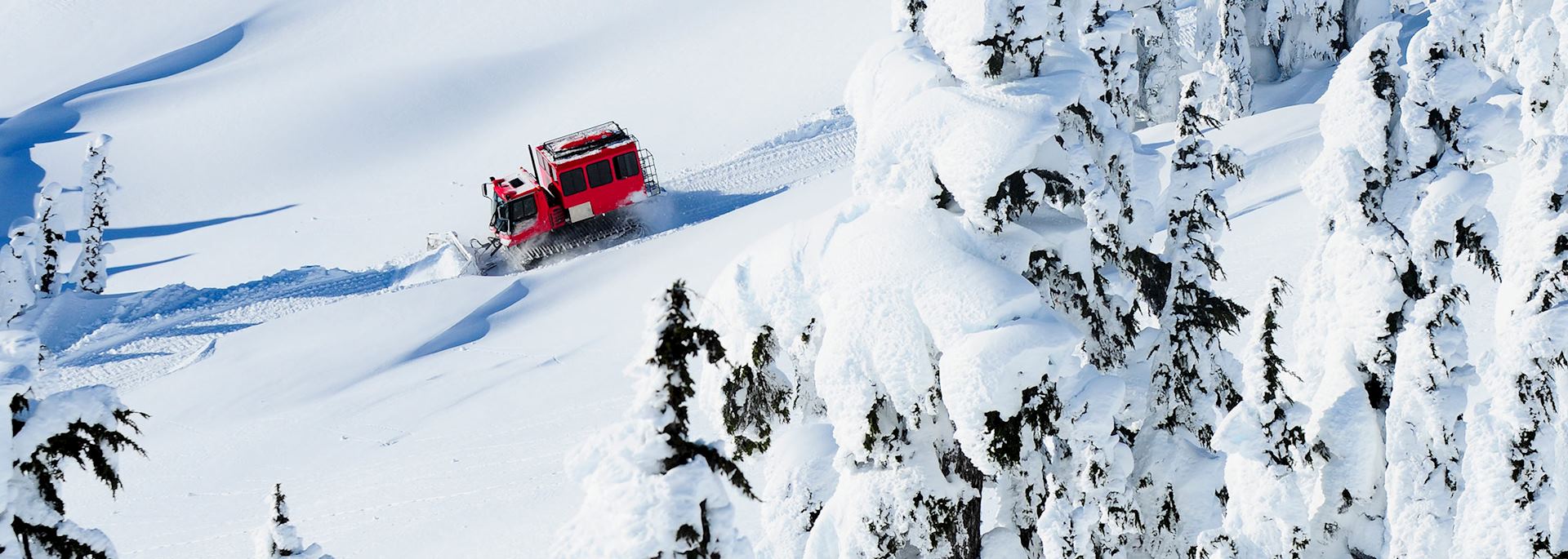By Canada specialist Lucy
Dog-sledding, snowshoeing, tubing — Canada’s winter landscape can be a literal snow-covered playground for children and adults alike. The cold temperatures and rigorous activities may better suit families over the age of 12, but if you want to travel with smaller children, you’ll still find plenty of things to do and see in Canada from November to April, depending on where in Canada you visit. Here, I’ve suggested what I think are the four best destinations for families, as well as some of the tours and activities that are suitable for children of all ages.
Frozen waterfalls, a winter hike and snow tubing in Banff
Just an hour and a half west of Calgary Airport, nestled within the Rocky Mountains, the alpine town of Banff thrives in the winter due to its proximity to three busy ski resorts. However, there’s also plenty to do for those who don’t want to spend time on the slopes.
It’s a good destination for families thanks to its compact size, which makes it easy to walk around even with young children. You’ll also find a wide variety of dining options, so picky eaters have a selection.
For me at least, the mountain landscape is more lovely when it’s blanketed in snow, and I find that winter activities are more invigorating. Ice skating is a popular pastime in Banff, and you’ll see people of all ages throughout the day and night on the town’s public rink. Located in the middle of Banff Avenue, the rink has wood-burning fires around it at night, so children (or adults) can warm up if they get cold.
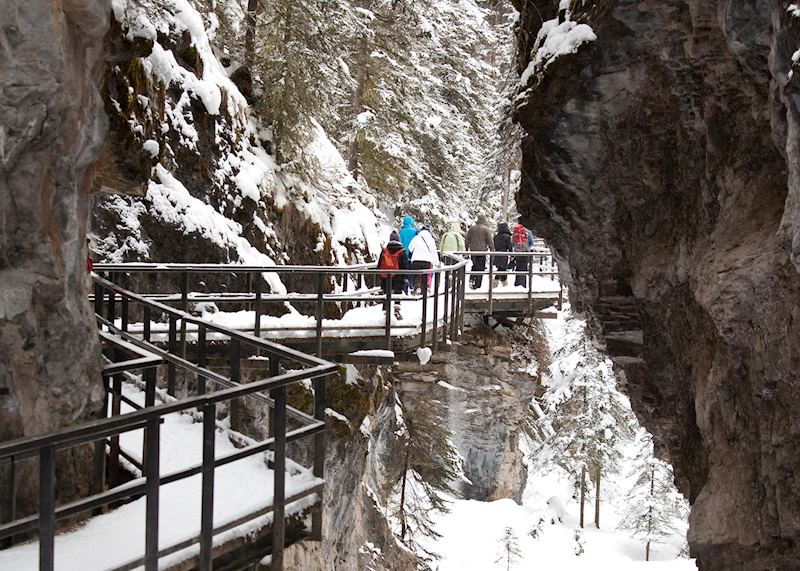
Nearby Mount Norquay has the largest tube park in Alberta, with eight lanes for inflatable snow tubing. There’s also a magic carpet system that pulls you back up to the top of the hill, so little legs don’t get too tired. The staff at the top will help children get safely in their tubes and even give them a little push if they want to go faster. Children over the age of four can take part, and older children and teenagers might like to visit on a Friday or Saturday night, when the tube park stays open after dark.
If your family are tired of the cold, there are also good indoor diversions in Banff. Despite its small size, Banff has some excellent museums, including the Luxton Museum, which examines the lives and history of the First Nations. Nearby, the Banff Gondola travels up Sulphur Mountain, with sweeping views from the top. You’ll also find an interactive museum here with hands-on displays that spotlight the park’s natural history. Children can have an activity book to work through and cookies to keep them content.
If you have older children who are up for a two-hour hike, I also suggest a guided ice walk through nearby Johnston Canyon. The Johnston Creek flows rapidly through the canyon in the summer, but in the winter months much of the water freezes, leaving behind a fantastical frozen landscape. The creek has eroded the limestone rock here for millions of years, forming sheer canyon walls, tunnels, waterfalls and pools.
The route includes hand rails, walkways and steel bridges, making it safe for children to explore. At the trailhead, your guide gives everyone a pair of ice cleats — I was astounded at how stable and comfortable the cleats made me feel, even on sheer ice.
For me, the highlight of this tour are the two falls. The lower falls are too powerful to freeze and the roar echoes through the canyon as you approach. The upper falls, however, are framed by massive cascades of blue-white icicles, forming pillars that attract ice climbers from across the region. I loved standing overlooking the upper falls, munching on a homemade cookie and clutching a cup of steaming hot chocolate provided by our guide.
A winter carnival in Canmore

Canmore sits on the edge of Banff National Park, just a 20-minute drive from Banff town. This mountain-town community boasts resort-style hotels and a number of winter activities, particularly during the Canmore Winter Carnival. It takes place over the first ten days of February and features ice-carving competitions, skating parties, street hockey, log-sawing contests and other traditional Canadian winter pastimes.
Canmore’s downtown pond is a popular spot with locals who come to skate. In addition to heated gazebos, where you can put your skates on, it’s also floodlit until 10pm, so you can twirl away under the stars.
Watch ice sculptors at Lake Louise
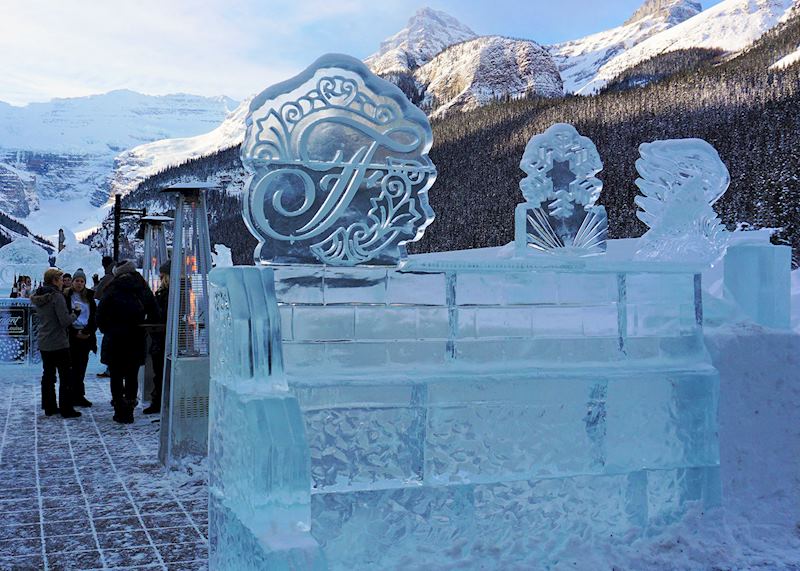
Known for its brilliant-blue water, Lake Louise draws hordes of people during the summer months. I prefer visiting in the winter, when the lake is frozen — not only are the crowds thinner, but the frost-spangled trees, snowy mountains and iced-over lake rival any summertime landscape, in my opinion.
You can go snowshoeing around the lake or ice skating on it. For a less energetic option, take a horse-drawn sleigh ride around the lake edge — children stay warm tucked under a snug blanket. Families looking for an adrenaline rush might enjoy the tubing park at Lake Louise Ski Resort, just a ten-minute taxi ride from the lake.
The lake is usually cleared of snow and ready for skating in early December, and has separate rinks dedicated to figure skating and hockey. You can also explore the modest ice castle that’s built on the lake’s surface for most of the winter.
During the last two weeks of January, the Ice Magic Festival features world-class ice sculptures, and the lake’s surface sports these glittering, transient artworks for weeks after. You can watch the artists at work during the carving competitions, and cheer on the carvers during the speed-carving event.
Sleigh rides and snowshoe adventures in Whistler
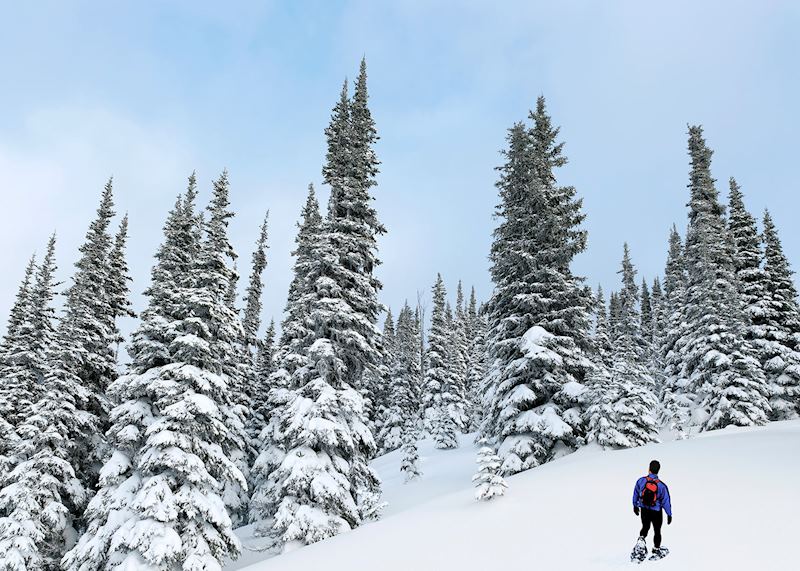
Whistler is immensely popular as a ski resort, and it’s become a hub for other outdoor winter activities in British Columbia. Visitors stay in a series of carefully designed mini-villages, making it a family-friendly destination.
If you’d like to take in the winter landscape, I suggest a horse-drawn sleigh pulled by two gentle Percheron horses. The route loops around Blackcomb Mountain, stopping at a rustic cabin along the way where you can warm up by the fire and sip hot chocolate.
If you’re visiting with older children, you can try tubing at Whistler Blackcomb Tube Park, which has seven tube lanes and a magic carpet system that takes riders back to the top. Aspiring skaters can visit the Whistler Olympic Plaza, a rink right in the middle of the village, or the Meadow Park Sports Centre in the north of the village, which has an NHL-sized indoor ice rink. You can also take a heated snowcat up the mountain to a log cabin, where you can indulge in a fondue dinner at an altitude of 1,828 m (6,000 ft).
I also recommend a guided snowshoe walk along Whistler’s medicine trail in the ancient forest of the Callaghan Valley. The path, which was once used by trappers, weaves between giant cedar, fir and hemlock trees that form a high canopy above.
Along the way, your guide paints a vivid picture of the traditional medicines that the First Nations people of Canada used. I even sampled some healing teas made from the plants along the trail. Snowshoeing for two to three hours is thirsty work, so the tour culminates with a visit to a traditional caboose (railway cabin), where you can enjoy a hot drink and a snack.
Mush your own team of Alaskan huskies
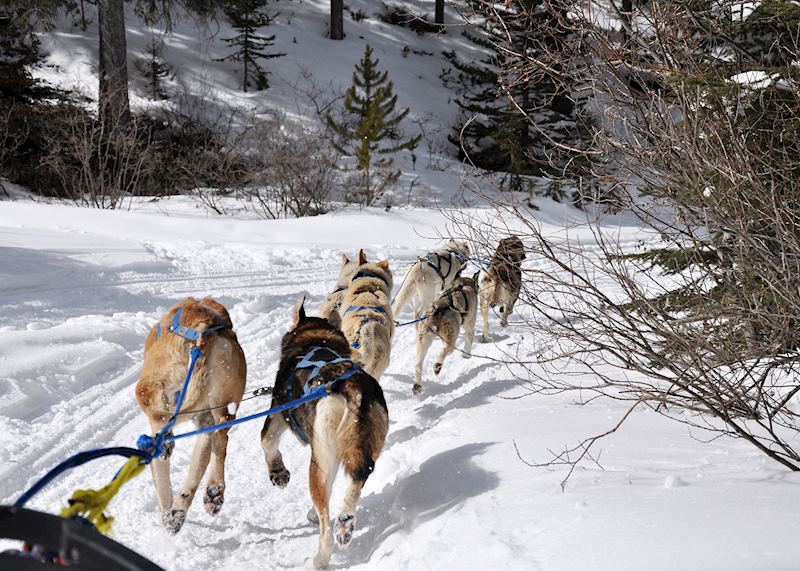
One of the most exciting things I’ve ever done in Canada was mushing my own team of Alaskan huskies through a wintry landscape in Valemount, British Columbia, an hour-and-a-half northwest of Jasper.
The most important moment, at the very start of my mushing adventure, was meeting the team of dogs: Kilo, Freida, Stanley, Igloo, Rio, Malibu, Scout, Princess and Alpha. Big, muscular and thickly furred, the huskies were amusingly egalitarian — when I fussed over one, the others all panted for my attention.
Having met and petted the dogs, I learned the basics of mushing, including the commands like ‘gee’ for right and ‘haw’ for left. The cleverest dogs were put in the front, to steer the pack, and the strongest were stationed at the back, to pull the sled quickly over the snow.
Trusting the dogs to do most of the work, I stepped onto my sled and headed off, shouting commands at my team. My lead dog, Freida, knew her lefts and rights well, steering us the correct way every time as she led the others. We followed a path about 10 km (6 miles) into the snow-hushed woods, the icy wind whipping at my face as we raced along under the tree boughs.
Before we turned back, my guide and I (and the dogs) stopped for a campfire lunch of sausages, cheesy rolls and homemade sweet treats, as well as hot apple cider from a flask. It was a very cold day, so this was a welcome interlude. And, on returning to base, the dogs were given a well-earned chicken broth dinner.
